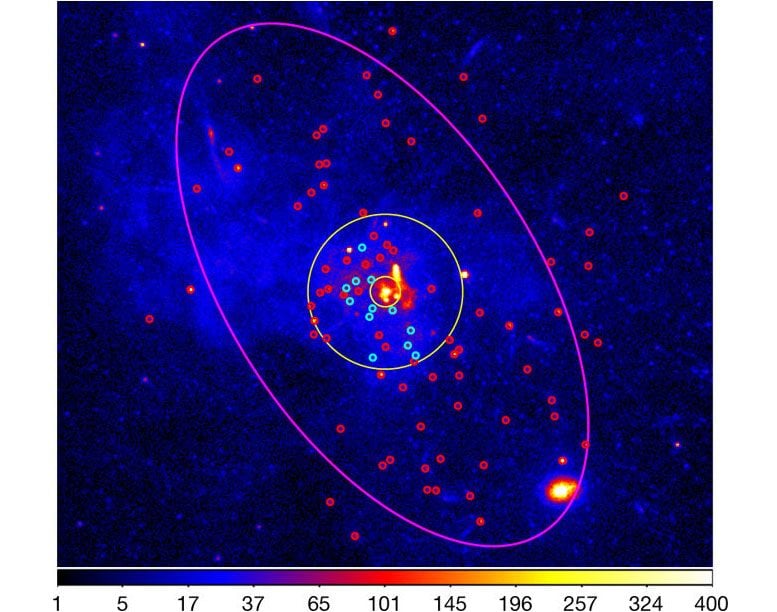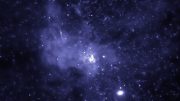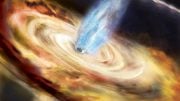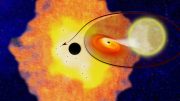
Chandra 2–8-keV image of the Galactic Center with X-ray sources with C ≥ 100 overlaid. Thermal (HR2 > 0.3) and non-thermal (HR2 < 0.3) sources are indicated with red and cyan circles, respectively. The color scale indicates the number of 2–8-keV counts per pixel. The inner and outer yellow circles delineate the 0.2 pc < r < 1 pc region around Sgr A*. The inner region was excluded from the analysis. The magenta ellipse (7.8 pc × 3.9 pc, full-width at half-maximum) bounds the region of spatially unresolved hard X-ray emission that was discovered by NuSTAR and is due to thermal emission from intermediate polars. The non-thermal sources cluster inside the inner parsec, whereas the thermal sources are distributed more uniformly throughout the hard X-ray emission. The Galactic plane runs along the semi-major axis of the ellipse. The dearth of sources to the north of the Galactic plane is due to strong extinction from molecular clouds (such as the circumnuclear disk), which densely populate that region. This may reduce the estimated number of sources by a factor of a few. Some bright sources without circles are X-ray transients, including the outbursting neutron-star low-mass X-ray binary AX J1745−2901 in the lower right corner. For reference, Chandra’s angular resolution is 0.5 arcsec, which corresponds to about 0.025 pc at the Galactic Center. Credit: Nature (2018) doi:10.1038/nature25029
The center of our Milky Way galaxy is about twenty-five thousand light-years from Earth, in the direction of the constellation Sagittarius. At the core of the galaxy is a supermassive black hole with about four million solar masses of material and around it, within a volume just a few light-years in radius, orbit hundreds of massive stars and probably hundreds of thousands of smaller, harder to detect stars. The whole region is invisible to us in optical light because of the extensive amounts of absorbing, intervening dust. Other wavelengths, however, including infrared, radio, and energetic X-rays, can penetrate the veiling material and enable us to study this unique environment.
The supermassive black hole at a galaxy’s center is expected gradually to accumulate many small, stellar-mass black holes around it. In the case of our own galaxy, as many as 20,000 black holes may have settled around the central few light-years. So far, however, no such density cusp has been reported. One of the best ways to look for such black holes is via binary stars in which one member is a stellar-mass black hole, because accretion around the black hole would generate detectable X-rays.
Harvard-Smithsonian Center For Astrophysics (CfA) astronomer Jaesub Hong was a member of a six-person team that used the Chandra X-ray Observatory to search for such binaries. They examined the equivalent of several weeks’ worth of archival Chandra observations obtained over twelve years, in an area corresponding to a volume that stretches to about sixty light-years from the galactic nucleus. In this region, thousands of X-ray point sources are seen, produced by a range of processes including hot gas, stellar atmospheres, binaries with white dwarf star members, neutron stars, and black holes. The innermost region itself, out to about twelve light-years, has hundreds of sources. (For comparison, the nearest star to the Sun is four light-years away.) The X-ray energies of the sources can be used to diagnose their character, but in this dense complex source confusion was a challenge. To minimize the confusion, the team focused on relatively bright sources, about one hundred of them, and also used simulations as a reality check. They found that twelve of the sources in the central dozen light-years had relatively “soft” X-ray spectra consistent with these sources being black-hole binaries. Although some alternative explanations cannot be ruled out (for example, a class of pulsars), the observed X-ray properties of these sources are the first strong evidence for the population of black hole binaries predicted to settle near the galactic center. The results suggest there are a larger number of (still undetected) isolated BHs present, and not least emphasize the complex and fascinating nature of this unique location in our galaxy.
Reference: “A Density Cusp of Quiescent X-Ray Binaries in the Central Parsec of the Galaxy” by Charles J. Hailey, Kaya Mori, Franz E. Bauer, Michael E. Berkowitz, Jaesub Hong and Benjamin J. Hord, 5 April 2018, Nature.
DOI: 10.1038/nature25029









In search of black holes and dark matter astrophysicists are relying on indirect observations. It would seem that the measurement of the event horizon of a black hole directly would be a direct evidence. However, by the nature of a horizon, any real measurement of the event horizon will be indirect. The Event Horizon Telescope will get picture of the silhouette of the Sgr A* which is due to optical effects of spacetime outside of the event horizon. The result will be determined by the simple quality of the resulting image that does not depend on the properties of the spacetime within the image. So, it will be also indirect and an existence of BH is a hypothesis.
https://www.academia.edu/12468184/Are_there_Black_Holes_and_Dark_Matter_in_the_Milky_Way